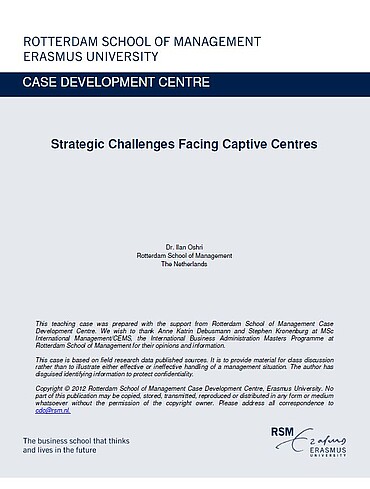Citation Note
Based on generalised experience; 20 pages.
Follow the 'handle' link to access the Case Study on RePub.
For EUR staff members: the Teaching Note is available on request, you can contact us at rsm.nl/cdc/contact/
For external users: follow the link to purchase the Case Study and the Teaching Note.
Objective
The key objective of this teaching case is to encourage managers and executives to think about their offshore assets in a strategic way. While the early adapters of offshore strategies perceived the offshoring of back office operations as a move driven by cost efficiencies, evidence from recent years has shown that in fact growth strategies and access to unique skills are becoming some of the dominating factors in the setting up of captive centres. Therefore, each challenge identified in the teaching case should be examined from the perspectives of both cost reduction and growth strategies. Furthermore, the teacher should also consider comparing the option of setting up a captive centre versus contracting with a 3rd party offshore outsourcing vendor or setting up a joint venture with a local vendor. By examining these options, managers and executives will engage in a strategy-making exercise in which the starting-point of where to locate activity X will lead to a more operational decision, such as through which offshore vehicle and with which particular partner. The managers and executives should discuss the following questions: 1. In the context of the make-buy decision, how would you position and describe the captive centre option? 2. Why have multinationals pursued a pure captive centre option? Is the captive centre a cheaper option than an offshore-outsourcing contract? 3. What “problems” may GlobalSoftware have resolved by outsourcing hosting services to a local vendor, and what ‘new problems’ have emerged? 4. Was the decision to divest the majority of GlobalAirline a wise one? 5. Taking into account the strategic moves discussed in the case and beyond, how should executives think about the evolutionary path of the captive centre, and what strategic options can be pursued when local market conditions such as the demand and supply of services and talent are considered?
description
The growing Indian IT service sector has forced Western multinationals to rethink their captive center strategy. The case shows how the basic concept of captive center has transformed over time.
Abstract
Firms such as General Electric, Texas Instruments and Motorola, who established captive centers in India in the mid-1990s, had traditionally kept most of their offshored tasks in-house. Since then, however, the Indian IT service sector has grown and developed abilities to carry out both simple and complex IT maintenance and development, often more cheaply than their Western competitors. This development has forced Western multinationals to consider how to better utilize their offshore assets. For example, in 2006, SAP Hosting Services in Bangalore outsourced several hosting services to Tata Consultancy Services, also based in Bangalore. Other companies, such as Standard Chartered and Hewlett Packard, have followed a different approach in which their captive centers provided services to both parent company and external service providers. British Airways, on the other hand, sold a majority stake of its captive centre to the private equity firm Warburg Pincus in 2002. Apple Inc. went even further and closed down its development centre in India in 2006. Clearly, such changes suggest that the basic concept of the captive center is transforming.
usage
This is the only teaching case on the evolution of offshoring strategy. The audience can benefit from gaining insight into offshoring and the changes that have taken place in the offshoring industry.
